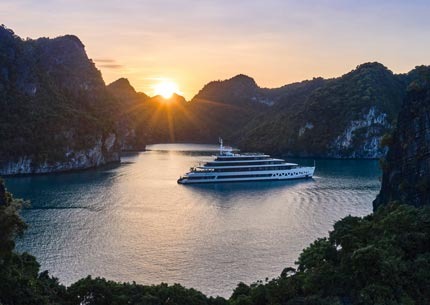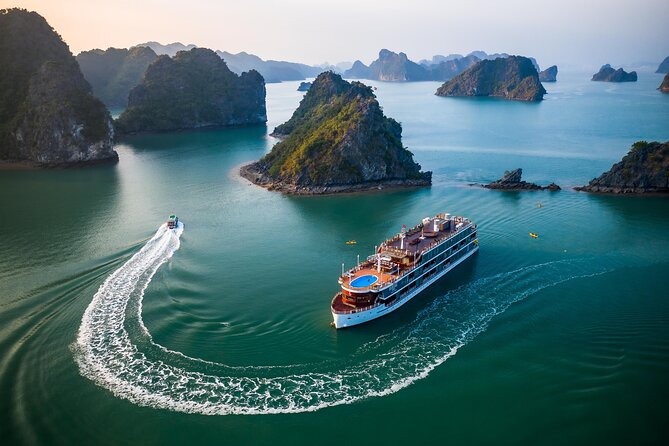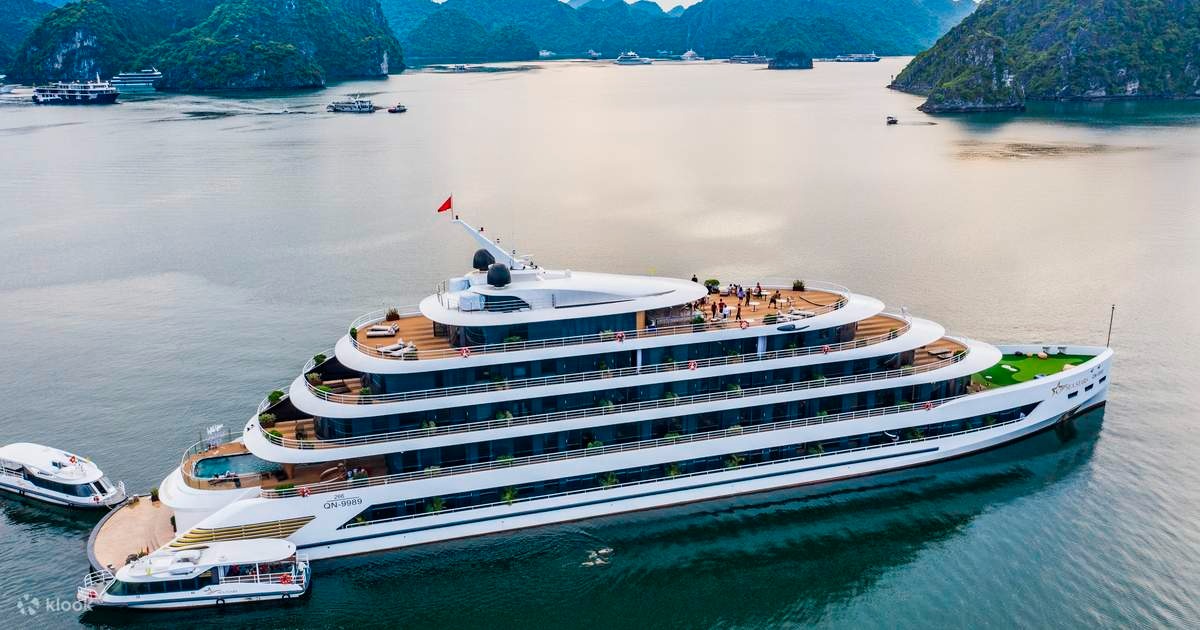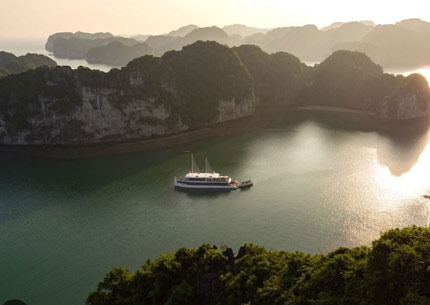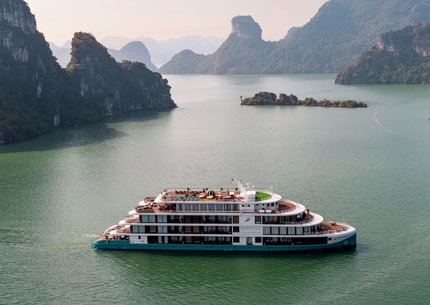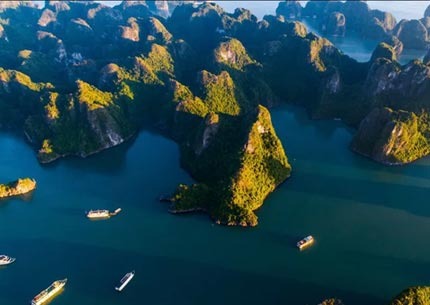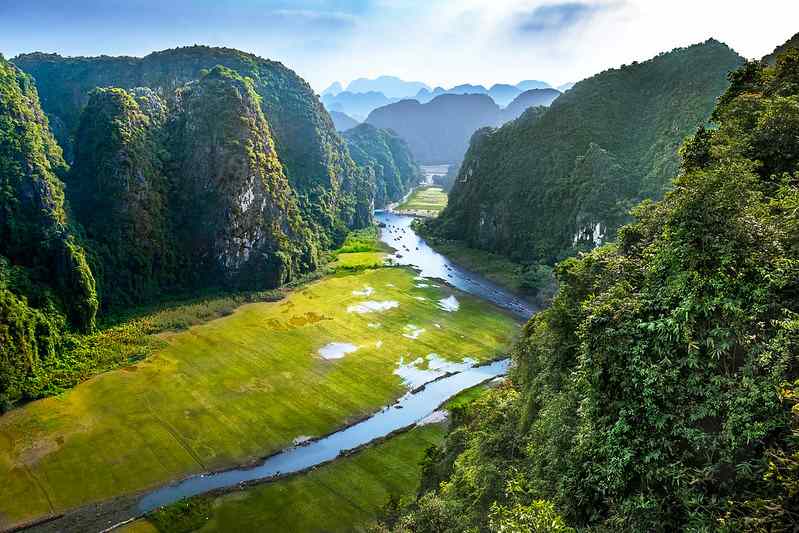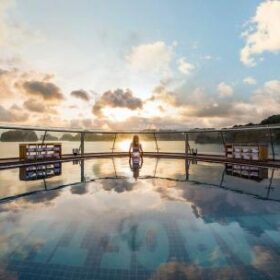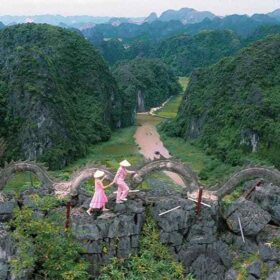The Short Answer: Yes, But You Need to Plan It Right
If you’re wondering whether Halong Bay is worth visiting in 2025, the answer is a resounding yes—but with important caveats. This UNESCO World Heritage Site remains one of Vietnam’s most spectacular natural wonders, offering breathtaking scenery you simply can’t find anywhere else. However, to truly experience the magic that makes Halong Bay special, you need thoughtful planning to navigate concerns about overtourism, environmental issues, and finding authentic experiences.
As someone who has guided countless visitors through this limestone paradise, I’ll share honest insights that go beyond glossy brochure descriptions to help you decide if Halong Bay deserves a spot on your Vietnam itinerary—and how to make it truly worth every penny and minute invested.
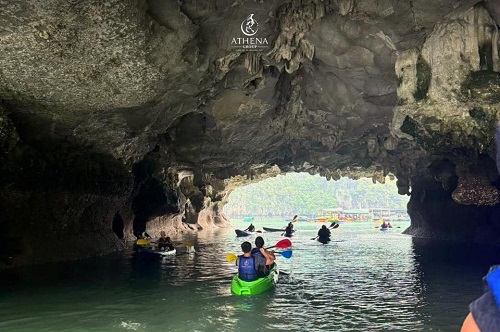
What Makes Halong Bay Special: A Natural Wonder Millions of Years in the Making
Nestled in the Gulf of Tonkin in northeastern Vietnam, Halong Bay stands as a geological masterpiece unlike any other place on earth. With over 1,600 limestone karsts and islets rising dramatically from emerald waters, the landscape tells a story millions of years in the making. These towering formations, sculpted by wind and water over millennia, create a maze of natural beauty that changes with every angle and shifting light.
The name “Halong” translates to “descending dragon,” reflecting the local legend that the bay was formed when a dragon charged toward the coast, its tail carving valleys and crevasses that filled with water when it plunged into the sea. This mythical origin story adds a layer of cultural richness to the already impressive natural setting.
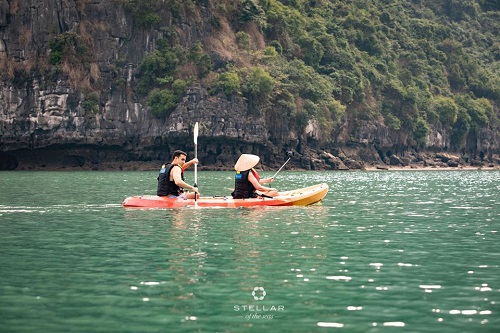
The Science Behind the Scenery
What makes Halong Bay truly remarkable from a geological perspective is its exemplary display of karst topography. The limestone formations began forming roughly 250 million years ago when the area was a shallow sea. Over time, calcium-rich marine organisms died and accumulated on the seafloor, eventually compressing into limestone. As tectonic activity lifted these limestone layers above sea level, the relentless work of erosion began.
Rain, slightly acidic due to dissolved carbon dioxide, gradually dissolved the limestone along fractures and faults, creating the dramatic towers we see today. This process, called karstification, continues even now—making Halong Bay not just a static landscape but a living, evolving geological wonder.
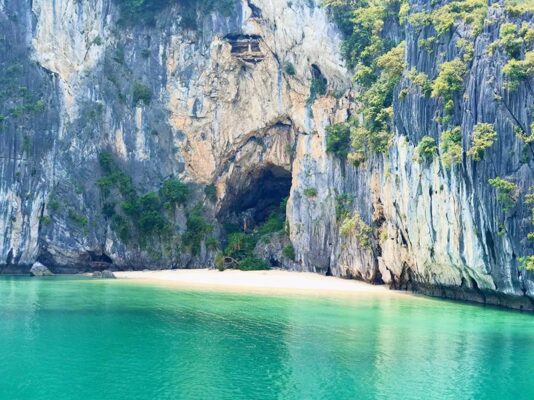
Common Concerns: Addressing the “Is It Worth It?” Question Head-On
Before diving into planning details, let’s address the most common concerns that make travelers question whether Halong Bay is worth visiting:
1. Overtourism and Crowds
The Concern: Many travelers worry that Halong Bay has become too popular, with photos showing boats clustered together and crowds diminishing the experience.
The Reality: While the main routes in Halong Bay proper can indeed get crowded, particularly during peak season, there are excellent alternatives. Bai Tu Long Bay and Lan Ha Bay offer nearly identical limestone scenery with a fraction of the tourist traffic. Strategic timing of your visit and choosing the right cruise operator can make a dramatic difference in your experience.
2. Environmental Issues
The Concern: Reports of pollution, trash in the water, and environmental degradation have made eco-conscious travelers hesitant.
The Reality: Environmental challenges do exist, particularly in high-traffic areas. However, significant improvements have been made since 2017 when authorities implemented stricter regulations. By 2025, many operators have adopted sustainable practices, and certain areas of the bay remain pristine. Choosing environmentally responsible cruise companies directly supports conservation efforts.
3. Cost vs. Value
The Concern: A quality Halong Bay cruise isn’t cheap, leading many to question if the experience justifies the price tag.
The Reality: While budget options exist, they often lead to the disappointing experiences that prompt the “is it worth it” question in the first place. Mid-range and luxury cruises (ranging from $150-500 per person for overnight experiences) provide significantly better value through smaller groups, access to less-visited areas, higher quality food, and more knowledgeable guides—all factors that dramatically enhance your experience.
4. Time Investment
The Concern: Getting to Halong Bay requires at least a day trip from Hanoi, with many recommending overnight stays.
The Reality: The journey from Hanoi to Halong Bay takes approximately 2.5-3 hours each way with the new highway. While a day trip is possible, it results in a rushed experience with limited appreciation of the bay’s changing moods. A one-night cruise represents the minimum recommended time investment, with two nights being ideal for those seeking a deeper connection with this natural wonder.
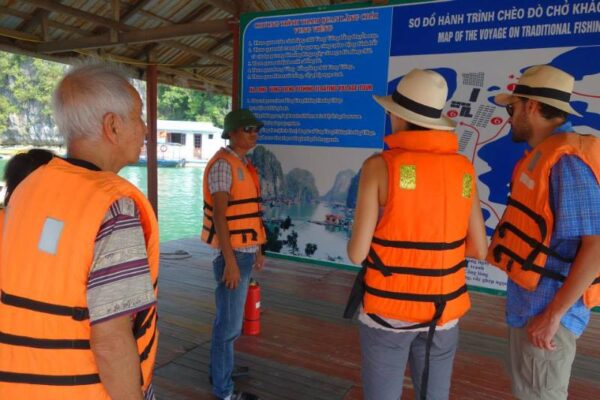
Planning Your Perfect Visit: When to Go and What to Expect
The Best Time to Visit Halong Bay in 2025
Timing is crucial for the best experience in Halong Bay, with each season offering distinct advantages and challenges:
March to May (Spring): ★★★★☆
- Weather: Pleasant temperatures (70-80°F/21-27°C) with increasingly clear skies
- Water Visibility: Good for swimming and snorkeling, though occasional agricultural haze can affect long-distance views
- Crowds: Moderate, with May seeing increasing domestic tourism
- Value: Very good, with shoulder season pricing before summer peak
September to November (Fall): ★★★★★
- Weather: Ideal conditions with comfortable temperatures, clear visibility, and lower rainfall
- Water Visibility: Excellent, particularly in October and November
- Crowds: Lower than peak season, especially after October 1
- Value: Excellent, with perfect balance of good weather and reasonable pricing
December to February (Winter): ★★★☆☆
- Weather: Cooler temperatures (60-70°F/15-21°C) with occasional mist creating mystical landscapes
- Water Visibility: Moderate, with some days quite misty
- Crowds: Low except during Lunar New Year (Tet) holiday
- Value: Good for atmosphere, though cooler weather limits swimming
June to August (Summer): ★★★☆☆
- Weather: Hot and humid with occasional storms and higher rainfall
- Water Visibility: Variable, affected by rain and runoff
- Crowds: High, particularly with domestic and international school holidays
- Value: Lower due to combination of higher prices and less reliable weather
Choosing Your Cruise Experience: The Most Critical Decision
The vessel and itinerary you select will have the greatest impact on whether you find Halong Bay “worth it.” Here’s a breakdown of options based on time available and expectations:
Day Trip (8-10 hours): ★★☆☆☆
- Best for: Travelers with severe time constraints who want a glimpse of the bay
- Experience: Depart Hanoi early morning, arrive at bay around noon, 4-5 hours on water, return to Hanoi by evening
- What to expect: A brief introduction to the landscape with stops at 1-2 major attractions
- Limitations: Rushed experience, crowded areas only, minimal time to appreciate the changing moods of the bay
- Cost range: $50-80 per person
- Is it worth it? Only if absolutely unable to stay overnight—otherwise, not recommended
2 Day/1 Night Cruise: ★★★★☆
- Best for: Most travelers seeking a balanced experience
- Experience: Full afternoon on first day, overnight on bay, morning activities before noon departure
- What to expect: Kayaking, cave exploration, swimming (seasonal), and an overnight stay on the water
- Value-adds: Sunset and sunrise views, stargazing, morning tai chi, cooking demonstrations
- Cost range: $120-200 per person depending on vessel quality
- Is it worth it? Yes, this is the minimum recommended time for a satisfying experience
3 Day/2 Night Cruise: ★★★★★
- Best for: Those seeking deeper immersion and relaxed pace
- Experience: Two full nights on water with extended daytime exploration
- What to expect: All activities of shorter cruises plus access to more remote areas, additional excursions
- Value-adds: Time to truly relax, explore lesser-visited areas, deeper cultural experiences
- Cost range: $250-300+ per person
- Is it worth it? Absolutely, especially for nature lovers and photographers
Cruise Selection: Budget vs. Mid-Range vs. Luxury
Budget ($100-130/night): ★★☆☆☆
- Vessel quality: Basic amenities, often older boats with maintenance issues
- Group size: Large (30+ passengers)
- Itinerary: Standard routes in most crowded areas
- Food quality: Basic Vietnamese and international dishes
- Guide expertise: Variable, often limited English proficiency
- Is it worth it? Generally not recommended—these experiences lead to most negative reviews
Mid-Range ($140-150/night): ★★★★☆
- Vessel quality: Well-maintained with comfortable rooms and good facilities
- Group size: Moderate (15-25 passengers)
- Itinerary: Mix of popular sites and some less-visited areas
- Food quality: Good quality meals with multiple courses
- Guide expertise: Professional guides with solid English skills
- Is it worth it? Yes, offers excellent value for money and solid overall experience
Luxury ($150-200+/night): ★★★★★
- Vessel quality: Premium boats with spacious cabins, balconies, and upscale amenities
- Group size: Small (2-15 passengers)
- Itinerary: Customized routes accessing quieter areas
- Food quality: Gourmet meals featuring fresh seafood and international cuisine
- Guide expertise: Highly trained guides with excellent language skills and deep knowledge
- Is it worth it? For special occasions or those seeking exceptional comfort, absolutely
The Hidden Gem: Bai Tu Long Bay vs. Halong Bay Proper
One of my strongest recommendations for visitors seeking an authentic experience is to prioritize cruises that visit Bai Tu Long Bay instead of (or in addition to) the main Halong Bay area. Located northeast of Halong Bay proper, Bai Tu Long features equally stunning scenery with significantly fewer boats and tourists. The waters are cleaner, the experience more serene, and you’ll often find yourself in peaceful coves with only your vessel in sight.
Key differences:
- Boat traffic: 70-80% fewer vessels than in main Halong Bay areas
- Water quality: Noticeably clearer with less visible pollution
- Exclusivity: Many areas limited to operators with special permits
- Authenticity: Fishing villages less commercialized, more traditional
- Downsides: Slightly longer transit time, somewhat higher cost due to permits
Operators specializing in Bai Tu Long: Dragon Legend Cruise, Indochina Junk, and Signature Cruise offer excellent Bai Tu Long Bay itineraries.
Essential Experiences: What Makes Halong Bay Truly Worth It
Kayaking Through Limestone Corridors
Nothing compares to the intimate experience of paddling your own kayak through the narrow passages between karsts. As you glide through the still waters, you’ll discover hidden lagoons and secret caves that larger boats cannot access. The silence—broken only by the gentle splash of your paddle and calls of distant birds—creates a profound connection with this ancient landscape.
Pro tip: Request early morning kayaking sessions when the water is calm and most other tourists are still having breakfast. The light is magical, and wildlife is more active.
Exploring the Remarkable Caves
Halong Bay’s limestone karsts aren’t just impressive from the outside—many contain stunning cave systems with millennia-old formations. While Sung Sot (Surprise) Cave is the most famous and accessible, consider these options for a more memorable experience:
- Sung Sot Cave: The largest and most magnificent cave in Halong Bay, featuring stunning stalactites and stalagmites illuminated by thoughtful lighting that highlights their natural beauty. Despite being popular, its sheer scale and impressive formations make it worth visiting.
- Thien Cung Cave (Heavenly Palace): Less crowded than Sung Sot with intricate formations and interesting legends explaining the various shapes.
- Dark & Bright Cave: Accessible only by kayak or small bamboo boat, this cave system includes a passage through a dark limestone tunnel that opens into a bright, enclosed lagoon—a truly magical experience.
- Tien Ong Cave: Notable for important archaeological findings dating back 10,000+ years, offering both natural beauty and historical significance.
Visiting Floating Fishing Villages
Witnessing traditional Vietnamese maritime culture at villages like Cua Van or Vung Vieng provides cultural context and human dimension to your natural experience. These communities, where generations of fishermen have created homes atop the gentle waters of the bay, offer insights into a vanishing way of life.
While some villages have become more tourism-oriented in recent years, they still provide fascinating glimpses into how humans have adapted to life on water. The less-visited villages in Bai Tu Long Bay tend to offer more authentic cultural experiences.
Sunset and Sunrise Viewing
There’s nothing quite like watching the sun rise or set over Halong Bay. The changing light creates dramatic shadows and reflections across the limestone formations and water—a photographer’s dream and a moment of pure tranquility. These quiet moments, when the day-trippers have departed and the bay takes on a peaceful quality, often become travelers’ most cherished memories.
Best sunset viewing spots:
- Ti Top Island summit (requires climbing 400+ steps)
- From your cruise boat’s upper deck in Lan Ha Bay
- Bai Tho Mountain in Halong City (for those staying pre/post cruise)
Swimming and Snorkeling in Hidden Lagoons
During warmer months (April through October), swimming in the emerald waters surrounded by towering limestone cliffs creates an unforgettable sensory experience. While water clarity varies by season and location, the better cruise operators know secluded spots where visibility is best.
Snorkeling in Halong Bay won’t rival Southeast Asia’s top marine destinations, but certain areas around Lan Ha Bay offer glimpses of colorful fish, coral formations, and other marine life—especially if you venture away from the main tourist routes.
Responsible Tourism: Making Your Visit Sustainable
Environmental Considerations
Halong Bay faces environmental challenges due to its popularity. Consider these practices to minimize your impact:
- Choose cruise operators with strong environmental policies who actively participate in bay cleanup initiatives
- Bring your own reusable water bottle (many quality operators now provide filtered water stations)
- Avoid single-use plastics during your visit
- Never throw anything overboard or leave trash behind
- Support conservation programs when possible
- Consider operators like Bhaya Cruises, Indochina Junk, or Heritage Line, which have implemented significant sustainability initiatives
Cultural Respect
When visiting floating villages or interacting with local communities:
- Ask permission before taking photographs of residents
- Purchase locally made crafts to support traditional livelihoods
- Learn a few Vietnamese phrases to connect with locals
- Respect fishing areas and avoid disrupting local activities
- Consider contributing to community development programs that benefit villagers
Beyond the Basics: Making the Most of Your Experience
Beyond the Popular Routes
Request cruises that venture to less-visited areas like Lan Ha Bay or Bai Tu Long Bay. The additional travel time is rewarded with pristine environments and a more exclusive experience. In particular, the landscape around Cat Ba Island offers some of the most dramatic scenery with significantly fewer tourists.
Early Morning Activities
Join early tai chi sessions on the deck of your cruise ship as the sun rises over the karsts, or take morning kayak excursions when the waters are calmest and wildlife most active. These early hours offer a tranquility that transforms your experience from simply “seeing” Halong Bay to truly experiencing its essence.
Seafood Culinary Adventures
Halong Bay offers exceptional seafood cuisine that’s worth exploring. Don’t miss trying dishes prepared with the day’s fresh catch, often featuring local specialties like:
- Mantis shrimp (tom tít) grilled with chili and lime
- Sea snails prepared with lemongrass and garlic
- Horseshoe crab roe soup (considered a delicacy)
- Grilled squid stuffed with pork and herbs
- Various fish species steamed with Vietnamese herbs and techniques
Many cruises include cooking demonstrations where you can learn traditional preparation methods—a cultural souvenir that lasts long after your photos fade.
Practical Tips: Maximizing Value and Avoiding Disappointments
Booking Smart
- Book directly with cruise operators when possible—third-party sites often add significant markups
- Consider shoulder seasons (May and September) for the best balance of good weather and value
- Check recent reviews focusing on those from the last 6 months, as quality can change rapidly
- Look beyond price as your only criterion—the cheapest options often provide disappointing experiences
- Confirm itinerary details in writing, especially regarding which bays and sites you’ll visit
Packing Essentials for Halong Bay
- Lightweight, quick-dry clothing
- Swimwear (even in winter—some boats have heated pools)
- Comfortable walking shoes for cave explorations
- Sunscreen, hat, and sunglasses
- Light jacket or fleece (evenings can be cool, especially December-March)
- Insect repellent for summer months
- Motion sickness medication if you’re susceptible
- Camera with extra batteries (charging opportunities may be limited)
- Dry bag for electronics during kayaking
Health and Safety Considerations
- Most quality cruise operators maintain solid safety standards, but always:
- Listen carefully to safety briefings
- Check that your cabin has functional life jackets
- Note emergency exits and assembly points
- Follow guide instructions during activities
- Use provided safety equipment during kayaking and other excursions
- Stay hydrated, particularly during hot months
- Apply sunscreen regularly—reflection from water intensifies sun exposure
Is Halong Bay Worth It? Final Thoughts for 2025 Visitors
While increased tourism has changed aspects of Halong Bay over the years, its fundamental beauty remains breathtaking. By choosing the right season, selecting less-crowded areas like Bai Tu Long Bay, and adopting a mindful approach to your visit, you can still experience the wonder that has captivated travelers for generations.
In my assessment after guiding countless visitors through these waters, Halong Bay is absolutely worth visiting in 2025—if you approach it with the right expectations and planning. The key factors that determine whether you’ll find it worthwhile are:
- Time allocation: Commit to at least one overnight stay, preferably two
- Budget alignment: Be willing to invest in mid-range options at minimum
- Itinerary selection: Prioritize routes that include less-visited areas
- Seasonal timing: Visit during optimal weather periods (Mar-May or Sep-Nov)
- Mindset: Approach it as an immersive natural experience, not just a photo opportunity
Halong Bay isn’t just a destination—it’s a natural masterpiece that changes with the light, the seasons, and your own perspective. Take your time, look beyond the obvious photo opportunities, and allow yourself to be immersed in this extraordinary landscape that continues to inspire awe in all who visit.
For those willing to plan thoughtfully, Halong Bay remains not just “worth it” but an essential experience that ranks among Southeast Asia’s most spectacular natural wonders—a place where legend, geology, and cultural heritage combine to create something truly magical.
Frequently Asked Questions About Halong Bay
Is one day enough for Halong Bay?
While technically possible, a day trip provides only a superficial glimpse of what makes Halong Bay special. You’ll spend 5-6 hours in transit for just 4-5 hours on the water, limiting you to only the most crowded areas and missing sunrise/sunset experiences. For a truly worthwhile visit, stay at least one night.
Is Halong Bay too touristy now?
The main routes of Halong Bay proper have indeed become crowded, but alternatives like Bai Tu Long Bay and Lan Ha Bay offer nearly identical landscapes with significantly fewer tourists. By choosing these areas and traveling during shoulder seasons, you can still enjoy an authentic, peaceful experience.
When is the best time to avoid crowds in Halong Bay?
For the optimal balance of good weather and fewer crowds, visit in late September through early November or late March through April. Weekdays are noticeably less crowded than weekends year-round.
Can you swim in Halong Bay?
Yes, swimming is permitted in designated areas from April through October when water temperatures are comfortable (75-84°F/24-29°C). Water quality varies by location, with cleaner waters typically found in Bai Tu Long and Lan Ha Bays.
How much should I expect to pay for a good Halong Bay cruise?
For a quality experience that visits less-crowded areas with professional guides and good food, budget $150-250 per person for a one-night cruise or $250-400 for a two-night experience in 2025. Lower-priced options exist but often result in disappointment.
Is it better to book a Halong Bay cruise in advance or in Hanoi?
For quality cruises, booking 1-3 months in advance is recommended, especially during high season (October-April). Last-minute bookings in Hanoi typically result in either premium prices or being assigned to lower-quality vessels that couldn’t fill their capacity through advance bookings.
Which is better—Halong Bay, Bai Tu Long Bay, or Lan Ha Bay?
All three areas feature similar limestone karst landscapes, but:
- Halong Bay proper: Most famous, most developed, most crowded
- Bai Tu Long Bay: Nearly identical scenery, 70-80% fewer boats, cleaner waters
- Lan Ha Bay: Similar dramatic scenery, fewer limestone formations but lovely beaches
For most visitors, Bai Tu Long Bay offers the best overall experience in 2025.
- Hotline | WhatsApp: +84.978.358.422
- Phone | WhatsApp: +84.962.261.687
- Email: halongbayluxcruises@gmail.com
- vietnammarveltravel@gmail.com
- website:halongbayluxcruises.com
- Top Halong Bay Cruise Review on TripAdvisor

